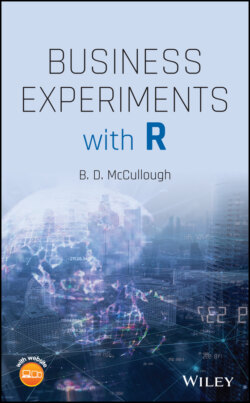Читать книгу Business Experiments with R - B. D. McCullough - Страница 26
Exercises
Оглавление1 1.2.1 Consider the five examples of lurking variables. We already described an experiment and a manipulated variable for the fire damage example. Come up with experiments and manipulated variables to expose the falsity of the observational conclusion for the bombing and drownings examples (we don't know the lurking variable for the other two).
2 1.2.2 For the following cases of observational data, articulate the precise nature of the sample selection.We wish to determine the effect of education on income by running a regression. (Think of the minimum wage.)Mutual funds that have been in business longer tend to have higher returns than newer mutual funds. We “know” this because we collected observational data on mutual funds, regressed return on number of years in business, and found that funds with more years had higher returns. (What happened to mutual funds with low returns?)
3 1.2.3 In the text, we asked, “If it is really the case that persons with higher credit limits are less likely to default, can we decrease the default rate simply by giving everybody a higher credit limit?” Definitely not! Why not? What is the lurking variable?
4 Using the data set credit.csv , create the variable “percentage default by age” () and plot it against age (). The relationship between and is definitely nonlinear. Describe the nonlinearity and a reason for it.
5 We know that regression results are biased when data have been selected due to a condition on the dependent variable, e.g. . What happens when the data are selected due to a condition on ? Subset the data for those values and run the regression. Is the slope estimate biased? What about the intercept? What can you conclude?
